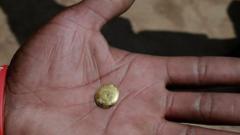The harsh realities of South Africa's illegal mining sector have come to light as shocking accounts reveal the sexual exploitation and trafficking of children. A recent investigation highlights the grim experiences detailed by Jonathan, who shared his harrowing story after spending six arduous months underground in an abandoned gold mine, formerly owned by now-defunct large multinational companies.
Speaking anonymously for fear of retaliation from the criminal gangs controlling these illegal operations, Jonathan recounted witnessing the abuse of minors, some as young as 15, who were lured into the mines with promises of financial gain. However, the reality exposes a darker truth—children often become victims of predatory adult miners who exploit their vulnerability through coercion and manipulation.
Campaigners have voiced concerns about the systemic abuses, with reports indicating that criminal organizations specifically target children for labor and, distressingly, sexual exploitation. Mining researcher Makhotla Sefuli emphasizes this alarming trend, noting that many children are trafficked from neighboring countries, only to have their identification documents seized upon arrival in South Africa.
Their plight became more widely known after a tragic incident at the Buffelsfontein mine near Stilfontein, which saw dozens of illegal miners trapped underground. Subsequent rescue efforts revealed harsh conditions as well as the presence of underage miners who had been subjected to unimaginable trauma.
Emergency operations conducted by South African authorities aimed to dismantle the thriving illegal mining industry have been met with significant challenges, as criminal elements continue to thrive amid insufficient oversight. Activists from organizations such as Save the Children South Africa have reported instances of deep psychological trauma among child miners due to their experiences, leading to long-term effects on their mental health.
Despite ongoing efforts to curb this crisis, the illegal mining industry shows no signs of abating, with estimates suggesting that around 6,000 mines remain vacant and undisturbed. As the cycle of exploitation persists, thousands of children continue to be at risk, raising urgent questions about accountability and the protection of vulnerable populations in the region.
The investigation has drawn attention to the critical need for robust policies and protective measures to safeguard these minors, who remain marginalized and voiceless in a landscape plagued by exploitation and violence. As authorities grapple with the complexities of addressing these issues, the urgent demand to protect the most vulnerable members of society stands clear.



















